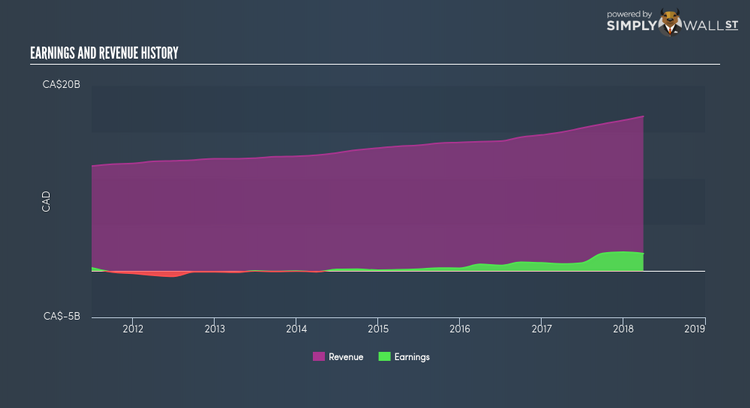Has Air Canada (TSE:AC) Improved Earnings Growth In Recent Times?

Assessing Air Canada’s (TSX:AC) past track record of performance is a useful exercise for investors. It allows us to understand whether the company has met or exceed expectations, which is a great indicator for future performance. Below, I assess AC’s latest performance announced on 31 March 2018 and evaluate these figures to its historical trend and industry movements. See our latest analysis for Air Canada
How Well Did AC Perform?
I prefer to use data from the most recent 12 months, which either annualizes the most recent 6-month earnings update, or in some cases, the most recent annual report is already the latest available financial data. This technique enables me to analyze various companies in a uniform manner using new information. For Air Canada, its most recent bottom-line (trailing twelve month) is CA$1.88B, which, in comparison to the previous year’s level, has soared up by over 100%. Given that these figures are fairly short-term thinking, I have calculated an annualized five-year figure for AC’s net income, which stands at CA$377.00M This means that, on average, Air Canada has been able to gradually raise its bottom line over the last couple of years as well.
What’s enabled this growth? Well, let’s take a look at whether it is merely owing to industry tailwinds, or if Air Canada has seen some company-specific growth. In the last couple of years, Air Canada grew its bottom line faster than revenue by successfully controlling its costs. This has caused a margin expansion and profitability over time. Looking at growth from a sector-level, the Canadian airlines industry has been growing its average earnings by double-digit 45.34% in the past twelve months, and 18.74% over the previous five years. This means whatever tailwind the industry is profiting from, Air Canada is able to amplify this to its advantage.
What does this mean?
Air Canada’s track record can be a valuable insight into its earnings performance, but it certainly doesn’t tell the whole story. Companies that have performed well in the past, such as Air Canada gives investors conviction. However, the next step would be to assess whether the future looks as optimistic. I recommend you continue to research Air Canada to get a more holistic view of the stock by looking at:
Future Outlook: What are well-informed industry analysts predicting for AC’s future growth? Take a look at our free research report of analyst consensus for AC’s outlook.
Financial Health: Is AC’s operations financially sustainable? Balance sheets can be hard to analyze, which is why we’ve done it for you. Check out our financial health checks here.
Other High-Performing Stocks: Are there other stocks that provide better prospects with proven track records? Explore our free list of these great stocks here.
NB: Figures in this article are calculated using data from the trailing twelve months from 31 March 2018. This may not be consistent with full year annual report figures.
To help readers see pass the short term volatility of the financial market, we aim to bring you a long-term focused research analysis purely driven by fundamental data. Note that our analysis does not factor in the latest price sensitive company announcements.
The author is an independent contributor and at the time of publication had no position in the stocks mentioned.

